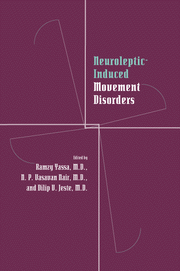Book contents
- Frontmatter
- Contents
- Contributors
- Preface
- Part I Historical perspective
- Part II Clinical aspects of tardive dyskinesia
- 2 Aging and tardive dyskinesia
- 3 Gender as a factor in the development of tardive dyskinesia
- 4 The Yale tardive dyskinesia study: a prospective incidence study among long-term outpatients
- 5 Vulnerability to tardive dyskinesia in schizophrenia: an exploration of individual patient factors
- 6 Tardive dyskinesia and affective disorder
- 7 Diabetes mellitus and tardive dyskinesia
- 8 Other factors in the development of tardive dyskinesia
- 9 Neuroleptic treatment and tardive dyskinesia
- 10 Anticholinergic drugs as factors in the development of tardive dyskinesia
- Part III Mechanisms underlying tardive dyskinesia
- Part IV Measurement of tardive dyskinesia
- Part V Tardive dyskinesia in different populations
- Part VI Other neuroleptic-induced movement disorders
- Part VII Treatment of tardive dyskinesia
- Index
6 - Tardive dyskinesia and affective disorder
from Part II - Clinical aspects of tardive dyskinesia
Published online by Cambridge University Press: 09 October 2009
- Frontmatter
- Contents
- Contributors
- Preface
- Part I Historical perspective
- Part II Clinical aspects of tardive dyskinesia
- 2 Aging and tardive dyskinesia
- 3 Gender as a factor in the development of tardive dyskinesia
- 4 The Yale tardive dyskinesia study: a prospective incidence study among long-term outpatients
- 5 Vulnerability to tardive dyskinesia in schizophrenia: an exploration of individual patient factors
- 6 Tardive dyskinesia and affective disorder
- 7 Diabetes mellitus and tardive dyskinesia
- 8 Other factors in the development of tardive dyskinesia
- 9 Neuroleptic treatment and tardive dyskinesia
- 10 Anticholinergic drugs as factors in the development of tardive dyskinesia
- Part III Mechanisms underlying tardive dyskinesia
- Part IV Measurement of tardive dyskinesia
- Part V Tardive dyskinesia in different populations
- Part VI Other neuroleptic-induced movement disorders
- Part VII Treatment of tardive dyskinesia
- Index
Summary
Neuroleptic antipsychotic drugs are used in the treatment of a variety of psychiatric conditions, including affective disorder. This chapter concerns the association between tardive dyskinesia and affective disorder, inasmuch as affective illness has been established as a risk factor in the development of tardive dyskinesia (Gardos & Casey, 1984; Casey, 1988). The evidence for this association will be reviewed, and possible mechanisms will be considered. Because the somatic treatments used for bipolar and unipolar patients may influence the development and manifestations of tardive dyskinesia, we shall briefly review the effects on tardive dyskinesia of antidepressants, electroconvulsive treatment (ECT), lithium carbonate, and anticonvulsants.
Epidemiology
The earliest relevant studies grew out of clinical observations that some tardive dyskinesia patients were experiencing concurrent depression or had been depressed in the past (Rosenbaum et al., 1977). Other studies suggested that many patients with tardive dyskinesia had been improperly diagnosed as schizophrenic and that the more appropriate psychiatric diagnosis would have been affective disorder (Davis, Berger, & Hollister, 1976; Rush, Diamond, & Alpert, 1982; Casey & Toenniessen, 1983). Several studies compared tardive dyskinesia patients with non-dyskinetic control subjects and found affective disorder to be more common in the tardive dyskinesia groups (Hamra et al., 1983b; Alpert & Rush, 1984; Wolf et al., 1985). In a recent study, Yassa et al. (1992) showed that major depression among tardive dyskinesia patients was significantly more frequent (12 of 20, or 60%) than was primary degenerative dementia (42 of 49, or 24.5%) among a cohort of psychogeriatric inpatients.
- Type
- Chapter
- Information
- Neuroleptic-induced Movement DisordersA Comprehensive Survey, pp. 69 - 81Publisher: Cambridge University PressPrint publication year: 1996
- 1
- Cited by

